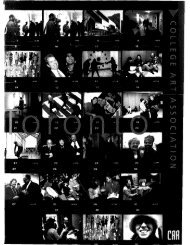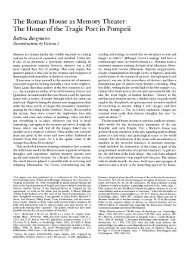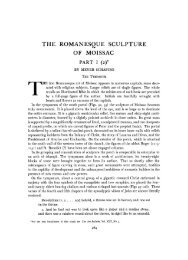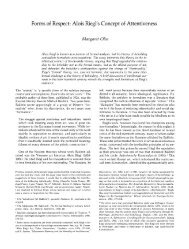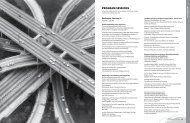THE HUMANISTIC THEORY OF PAINTING - College Art Association
THE HUMANISTIC THEORY OF PAINTING - College Art Association
THE HUMANISTIC THEORY OF PAINTING - College Art Association
Create successful ePaper yourself
Turn your PDF publications into a flip-book with our unique Google optimized e-Paper software.
UT PICTURA POESIS: <strong>HUMANISTIC</strong> <strong>THE</strong>ORY <strong>OF</strong> <strong>PAINTING</strong> 217<br />
art. Of these Reynolds was fully aware when he wrote his opinion of the Marie de' Medici<br />
series; for although he agreed with Du Bos that Rubens was at fault in mixing allegori-<br />
cal figures with real personages, he also insisted that in sacrificing truth to nature, Rubens<br />
gained another kind of truth that was more significant. "If," says Reynolds, "the artist<br />
considered himself as engaged to furnish this gallery with a rich, various and splendid<br />
ornament, this could not be done, at least in an equal degree, without peopling the air<br />
and water with these allegorical figures; he therefore accomplished all that he purposed.<br />
In this case all lesser considerations, which tend to obstruct the great end of the work,<br />
must yield and give way."88 Reynolds would have been the first to admit that paint-<br />
ing can have a greater end than Rubens here fulfilled-such an end he discerned in the pro-<br />
found and overpowering invention of Michelangelo on the Sistine ceiling"9 the greatness<br />
of which, Reynolds knew, is no mere matter of rhetoric, or of pictorial brilliance, or, pace<br />
Lessing, of bodily beauty either; nevertheless, on the subject of pictorial allegory Reynolds<br />
spoke a more decisive word than Lessing when he continued his criticism of the Luxem-<br />
bourg paintings as follows: "It must always be remembered that the business of a great<br />
painter is to produce a great picture; he must therefore take special care not to be cajoled<br />
by specious arguments out of his materials.<br />
"What has been so often said to the disadvantage of allegorical poetry,-that it is<br />
tedious, and uninteresting,-cannot with the same propriety be applied to painting, where<br />
the interest is of a different kind. If allegorical painting produces a greater variety of ideal<br />
beauty, a richer, a more various and delightful composition, and gives to the artist a greater<br />
opportunity of exhibiting his skill, all the interest he wishes for is accomplished; such a<br />
picture not only attracts, but fixes the attention."<br />
Lessing would certainly have retorted that Rubens, like all painters of allegory, had<br />
been cajoled out of his main argument by specious materials. And in so saying, he would<br />
have again displayed that uncompromising dialectic that resulted in vital distinctions in<br />
his criticism of poetry and painting, but which, because he did not understand painting,<br />
and had adopted a narrow conception of her scope of imitation, left her, in reality, not<br />
a sister of poetry at all, but a kind of lesser sister of sculpture bereft of her proper sen-<br />
suousness and of her proper range of expression. Lessing had excellent reasons both as<br />
a humanist and aesthetician for objecting probably to the bulk of allegorical painting. But<br />
he would not have been able to distinguish between the pictorial and imaginative brilliance<br />
of the Luxembourg series, and the "icily regular, splendidly null" allegorical histories, say,<br />
of Le Brun.<br />
III-EXPRESSION<br />
When Lessing objected to predominant expression in historical painting, he objected<br />
to something that the critics of the sixteenth century who developed the doctrine ut pictura<br />
poesis had insisted upon as fundamental. For if human beings in action are, as Aristotle<br />
said, the theme of painting, it follows that the movements of the body that express the<br />
affections and passions of the soul are the spirit and the life of art and the goal to which the<br />
whole science of painting tends. Lomazzo further insists that it is precisely here that<br />
painting most resembles poetry; for the inspired genius of both arts lies in the knowledge<br />
and power to express the passions, and the painter without expression, however perfect<br />
a stylist or technician he may be, must be prepared to endure the censure of posterity.90<br />
In the early Renaissance Alberti had included as essential to good composition an accurate<br />
88. Discourse vn.<br />
89. Discourse xv.<br />
90. See Appendix 3, "Lomazzo on Expression."



